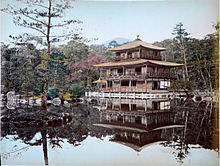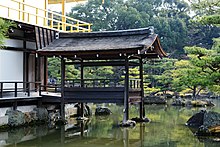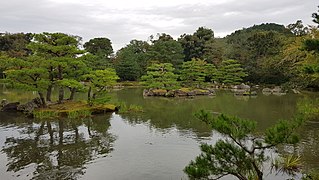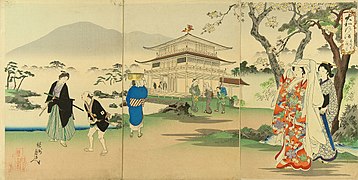Kinkaku-ji
| Rokuon-ji | |||||
|---|---|---|---|---|---|
鹿苑寺 | |||||
 | |||||
| Religion | |||||
Rinzai sect, Shōkoku-ji school | |||||
| Deity | Kannon Bosatsu (Avalokiteśvara) | ||||
| Location | |||||
| Location | 1 Kinkakuji-chō, Kita-ku, Kyōto, Kyoto Prefecture[1] | ||||
| Country | Japan | ||||
| Geographic coordinates | 35°02′22″N 135°43′43″E / 35.0395°N 135.7285°E | ||||
| Architecture | |||||
| Founder | Ashikaga Yoshimitsu | ||||
| Completed | 1397 1955 (reconstruction) | ||||
| Website | |||||
| www.shokoku-ji.jp/en/kinkakuji/ | |||||
| Japanese name | |||||
| Kanji | 金閣寺 | ||||
| Hiragana | きんかくじ | ||||
| Katakana | キンカクジ | ||||
| |||||
| Japanese name | |||||
| Kanji | 鹿苑寺 | ||||
| Hiragana | ろくおんじ | ||||
| Katakana | ロクオンジ | ||||
| |||||
Kinkaku-ji (金閣寺, lit. 'Temple of the Golden Pavilion'), officially named Rokuon-ji (鹿苑寺, lit. 'Deer Garden Temple'), is a Zen Buddhist temple in Kyoto, Japan.[2] It is one of the most popular buildings in Kyoto, attracting many visitors annually.[3] It is designated as a National Special Historic Site, a National Special Landscape and is one of 17 locations making up the Historic Monuments of Ancient Kyoto which are World Heritage Sites.[4]
History

The site of Kinkaku-ji was originally a villa called Kitayama-dai (北山第), belonging to a powerful statesman,

During the
On 2 July 1950, at 2:30 am, the pavilion was burned down
The present pavilion structure dates from 1955, when it was rebuilt.[2] The pavilion is three stories high, 12.5 meters (40 feet) in height.[9] The reconstruction is said to be a close copy of the original, although some have questioned whether such an extensive gold-leaf coating was used on the original structure.[3] In 1984, it was discovered that the gold leaf on the reconstructed building had peeled off, and from 1986 to 1987, it was replaced with 0.5 μm gold leaf, five times the thickness of the gold leaf on the reconstructed building. Although Japanese gold leaf has become thinner with the passage of time due to improved technology, the 0.5 μm gold leaf is as thick as traditional Japanese gold leaf.[10] Additionally, the interior of the building, including the paintings and Yoshimitsu's statue, were also restored. Finally, the roof was restored in 2003. The name Kinkaku (金閣 gold pavilion) is derived from the gold leaf that the pavilion is covered in. Gold was an important addition to the pavilion because of its underlying meaning. The gold employed was intended to mitigate and purify any pollution or negative thoughts and feelings towards death.[11] Other than the symbolic meaning behind the gold leaf, the Muromachi period heavily relied on visual excesses.[12] With the focus on the Golden Pavilion, the way that the structure is mainly covered in that material creates an impression that stands out because of the sunlight reflecting and the effect the reflection creates on the pond.
Design details

The Golden Pavilion (金閣, Kinkaku) is a three-story building on the grounds of the Rokuon-ji temple complex.
Architectural design

The pavilion successfully incorporates three distinct styles of architecture, which are shinden, samurai and zen, specifically on each floor.[9] Each floor of the Kinkaku uses a different architectural style.[2]
The first floor, called The Chamber of Dharma Waters (法水院, Hō-sui-in), is rendered in
The roof is in a thatched pyramid with shingles.[14] The building is topped with a bronze hōō (phoenix) ornament.[13] From the outside, viewers can see gold plating added to the upper stories of the pavilion. The gold leaf covering the upper stories hints at what is housed inside: the shrines.[11] The outside is a reflection of the inside. The elements of nature, death, religion, are formed together to create this connection between the pavilion and outside intrusions.
Garden design
The Golden Pavilion is set in a Japanese strolling garden (回遊式庭園, kaiyū-shiki-teien, lit. a landscape garden in the go-round style).
The garden complex is an excellent example of Muromachi period garden design.[13] The Muromachi period is considered to be a classical age of Japanese garden design.[12] The correlation between buildings and its settings were greatly emphasized during this period.[12] It was an artistic way to integrate the structure within the landscape. The garden designs were characterized by a reduction in scale, a more central purpose, and a distinct setting.[15] A minimalistic approach was brought to the garden design by recreating larger landscapes in a smaller scale around a structure.[15]
Gallery
-
1930s travel poster
-
Entrance and ticket booth
-
Kinkaku-ji close up
-
Interior
-
Kinkaku-ji garden
-
The lower pond
-
White Snake Pagoda of Kinkaku-ji
-
Kinkaku-Ji, Kyoto in May 2019
-
Kinkaku-ji keychain
See also
- The Temple of the Golden Pavilion by Yukio Mishima, a novel loosely based on the 1950 destruction of Kinkaku-ji
- Buntenkaku in Nagoya, modeled after the Golden Pavilion
- Ginkaku-ji
- Shōkoku-ji
- Chūson-ji with golden Konjiki-dō
- Golden Tea Room
- List of Special Places of Scenic Beauty, Special Historic Sites and Special Natural Monuments
- Historic Monuments of Ancient Kyoto (Kyoto, Uji and Otsu Cities)
Notes
- ^ "Tourist Facilities of Japan - Kinkaku-ji Temple Garden". Japan National Tourism Organization. Retrieved 2010-07-15.
- ^ a b c d e f g h "Kinkakuji Temple - 金阁寺, Kyoto, Japan". Oriental Architecture. Retrieved 2010-07-13.
- ^ ISBN 0-7922-7563-2.
- ^ "Places of Interest in Kyoto (Top 15 most visited places in Kyoto by visitors from overseas)". Asano Noboru. Retrieved 2010-07-15.
- ^ a b c d e f g "Kinkaku-ji in Kyoto". Asano Noboru. Retrieved 2010-07-15.
- ^ ISBN 0-679-03011-5.[page needed]
- ^ Cartwright, Mark. "Kinkakuji". World History Encyclopedia. UNESCO. Retrieved 23 March 2021.
- Herostratos syndrome
- ^ a b c d e f g h Young, David, and Michiko Young. The art of Japanese Architecture. North Claredon, VT: Turtle Publishing, 2007. N. pag. Print.[page needed]
- ^ Kazuo Yaguchi. 金閣寺大修復 金閣修復 五倍箔 (in Japanese). Archived from the original on 23 October 2021. Retrieved 30 October 2022.
- ^ a b Gerhart, Karen M. The material culture of Death in medieval Japan. N.p.: University of Hawaii Press, 2009. N. pag. Print.[page needed]
- ^ a b c d “Pregil, Philip, and Nancy Volkman. Landscapes in History: Design and Planning in the Eastern and Western tradition. Hoboken, NJ: John Wiley & Sons Inc., 1992. N. pag. Print.”.
- ^ ISBN 0-7894-5545-5.
- ^ Young, David, Michiko Young, and Tan Hong. The material culture of Death in medieval Japan. North Claredon, VT: Turtle Publishing, 2005. N. pag. Print.
- ^ a b Boults, Elizabeth, and Chip Sullivan. Illustrated History of Landscape Design. Hoboken, NJ: John Wiley & Sons INc., 2010. N. pag. Print.
References
- Boults, Elizabeth, and Chip Sullivan. Illustrated History of Landscape Design. Hoboken, NJ: John Wiley & Sons, 2010.
- Gerhart, Karen M. The Material Culture of Death in Medieval Japan. Honolulu: University of Hawaii Press, 2009.
- Pregil, Philip, and Nancy Volkman. Landscapes in History: Design and Planning in the Eastern and Western Tradition. Hoboken, NJ: John Wiley & Sons, 1992.
- Young, David, and Michiko Young. The Art of Japanese Architecture. North Claredon, VT: Tuttle Publishing, 2007.
- Young, David, Michiko Young, and Tan Hong. Introduction to Japanese Architecture. North Claredon, VT: Periplus, 2005.
Further reading
- Kawaguchi, Yoko (2014). Japanese Zen Gardens (Hardback). London: Francis Lincoln. ISBN 978-0-7112-3447-5.
- ISBN 978-0-618-91522-4. OCLC 144227752.
External links
- Official site of Kinkaku-ji
- Oriental Architecture – Kinkakuji Temple
- Omamori Charms Amulets of Kinkaku-ji Temple
 Geographic data related to Kinkaku-ji at OpenStreetMap
Geographic data related to Kinkaku-ji at OpenStreetMap













